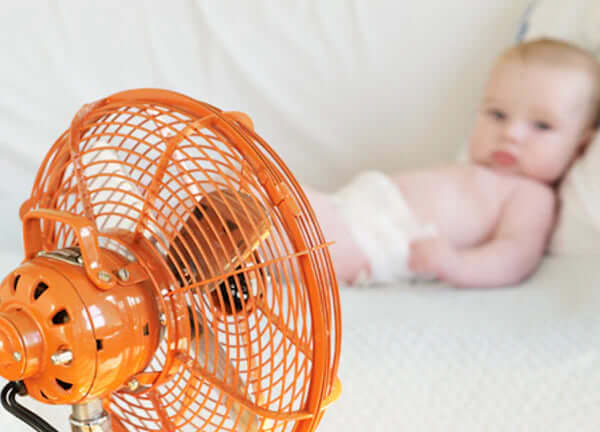When it comes to preparing your nursery for your little one, you’ve probably thought about the colours of the room, how you want to decorate it, and the preferred furniture you’d like to add. But have you thought about the air circulation in that room? This critically important detail is often overlooked. Or if it has been considered, you may have wondered what type of air circulation is best. Is air conditioning preferred? Or should babies sleep with a fan on?
If you’re asking these questions, you’re certainly not alone. Air circulation isn’t the most glamorous topic, but it is something worth considering. So, is it safe for your baby to sleep with a fan on? Absolutely.
Keep reading to learn about the importance of air circulation, and why having a baby sleep with a fan on is an effective way to help prevent SIDS.
What is SIDS?
First of all, what exactly is SIDS? SIDS stands for sudden infant death syndrome, and it’s the leading cause of death for babies between one month and one year old. While the cause of SIDS is still unknown and being researched, one common theory is that SIDS is due to the buildup of carbon dioxide in infants, i.e. accidentally suffocating while asleep.
If, for example, a baby is trapped by covered blankets or bedding, sleeping on their stomach, or sleeping too close to a family member, their airway may be blocked, resulting in sudden death of the infant. Believe it or not, a room that’s too hot can also interfere with a baby’s natural ability to breathe, making them more susceptible to SIDS.
Why Does a Fan Lower the Risk of SIDS?
SIDS is primarily caused by a lack of air ventilation and air circulation. A room that’s too hot and stuffy can also be a likely culprit for SIDS. Therefore, turning on a fan in your baby’s room is an effective way to help regulate a room’s temperature and provide vital air circulation and ventilation.
You may be wondering whether opening a window has the same effect as a fan. To some degree, it does. Cracking a window will ensure that the room is properly ventilated. However, a ceiling or portable fan is generally more effective at air circulation. In other words, a fan will help regulate the levels of carbon dioxide in a room.
Furthermore, studies have shown that by opening a window in a baby’s room, the risk of SIDS is reduced by 36%. On the other hand, sleeping with a fan in the room reduces the risk of SIDS by 72%. That means a fan has double the effectiveness of an open window.
Additional Benefits of Having a Fan in Baby’s Room
Beyond the obvious benefit of reducing the risk of SIDS, here are a few other benefits that come with turning on a fan in your baby’s room:
- White noise. Babies who learn to fall asleep to the sound of silence may be awakened more frequently due to background noises that they hear. White noise—which also mimics the sounds inside the womb—helps to muffle the noises outside the room so that your baby can fall asleep easier and stay asleep longer.
- Temperature. Regardless of where you live, there are probably seasons that are warmer than others. A fan will help keep those warmer temperatures at bay, helping to ensure a more comfortable room for your baby.
- Gentleness on skin. Because air conditioning alters the condition of the air, some babies with sensitive skin can develop eczema or respiratory problems such as asthma. On the contrary, a fan doesn’t change the condition of the air. Rather, it simply circulates it. Because of this, a fan can be gentler on your baby’s sensitive skin.
Precautions to Consider
Although the use of a fan can certainly help reduce the risk of SIDS, it’s important for parents to realize that there is much more to infant safety than simply placing a fan in their bedroom. The main piece of advice related to SIDS in the 90’s was to put your baby to sleep on their back. This advice still rings true today. Just because you’ve put a fan in your baby’s room doesn’t mean you should be negating other important factors such as back sleeping.
In addition to back sleeping, here are a few other important recommendations to consider:
- Keep your baby’s nighttime clothing on the lighter side to avoid overheating. Your baby should be dressed lightly, and the room temperature should be comfortable.
- Babies shouldn’t share the bed with you. Although you can place their crib in your room, it’s important that they sleep on a firm mattress in their own crib.
- Remove any soft objects or loose bedding from their crib. When your baby is sleeping, items such as toys, blankets, and pillows should be removed.
- Mothers who smoke during pregnancy and babies who are exposed to secondhand smoke are at the greatest risk for SIDS. Make sure that your baby is living in a smoke-free environment.
SIDS is a parent’s worst nightmare. And, although scientists don’t fully understand what causes it, we luckily have tons of information and resources to help prevent it. By ensuring that your baby’s room temperature is regulated and that the air is circulated, you greatly reduce the risk of SIDS. Plus, you’ll help create a comfortable environment for your baby to develop lifelong healthy sleep habits. Win-win.

